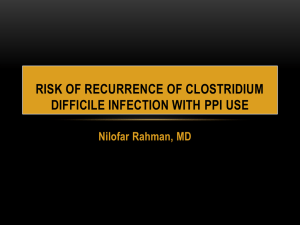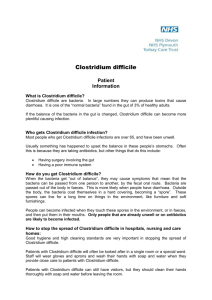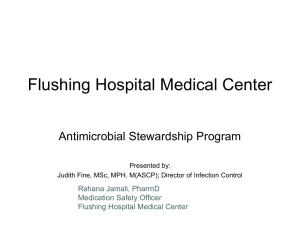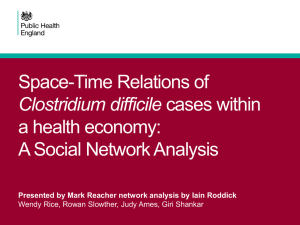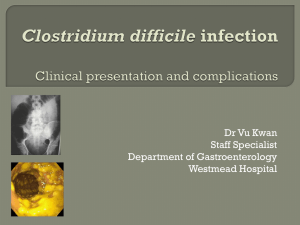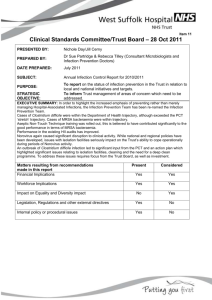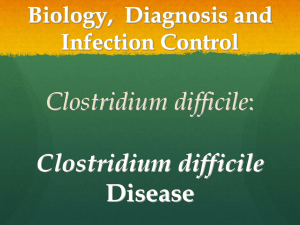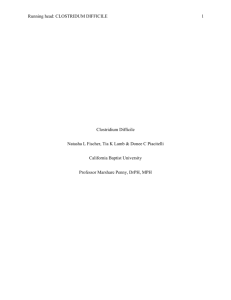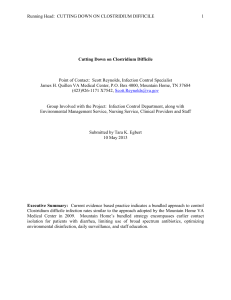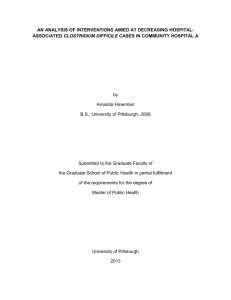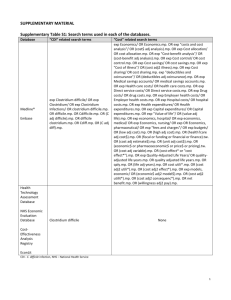Measures for the Prevention and Control of
advertisement
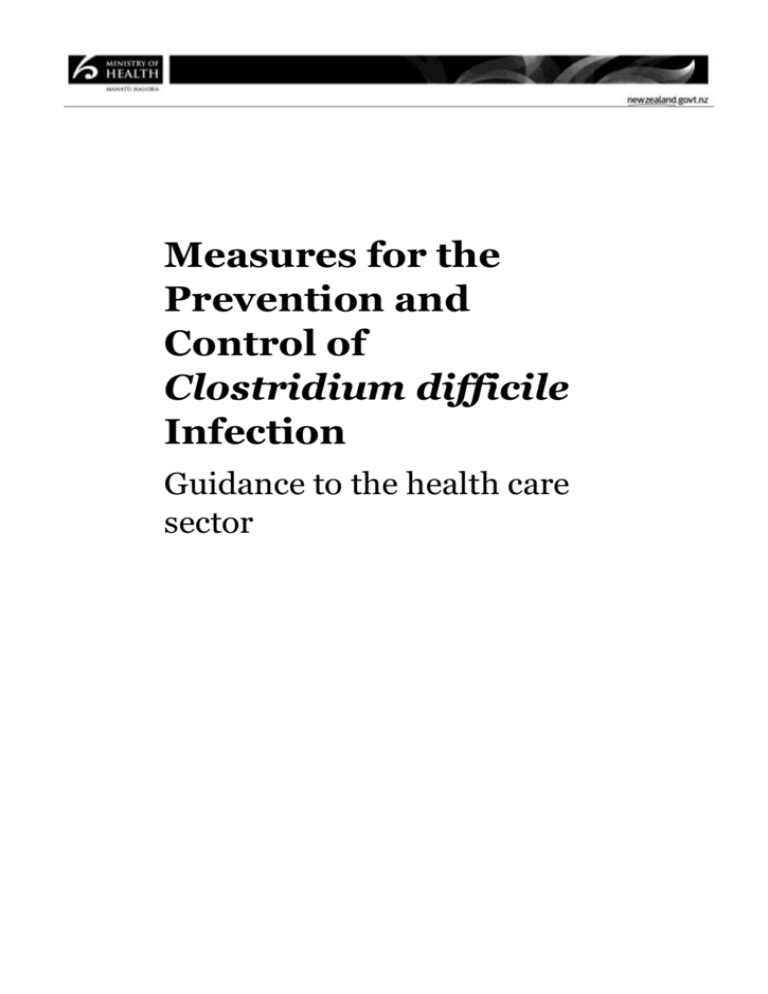
Measures for the Prevention and Control of Clostridium difficile Infection Guidance to the health care sector Citation: Ministry of Health. 2013. Measures for the Prevention and Control of Clostridium difficile Infection: Guidance to the health sector. Wellington: Ministry of Health. Published in November 2013 by the Ministry of Health PO Box 5013, Wellington 6145, New Zealand ISBN: 978-0-478-41556-8 (online) HP 5757 This document is available at www.health.govt.nz This work is licensed under the Creative Commons Attribution 4.0 International licence. In essence, you are free to: share ie, copy and redistribute the material in any medium or format; adapt ie, remix, transform and build upon the material. You must give appropriate credit, provide a link to the licence and indicate if changes were made. Contents Introduction 1 Contact precautions 2 Patient placement 2 Personal protective equipment 3 Hand hygiene 3 Patient care equipment 3 Patient transport 4 Environmental cleaning and disinfection 5 Laboratory testing 6 Bibliography 7 Appendix A: The Bristol Stool Chart 8 Appendix B: Commode Cleaning Poster 9 Measures for the Prevention and Control of Clostridium difficile Infection: Guidance to the health care sector iii Introduction Clostridium difficile (C. difficile) is a bacterium that causes inflammation of the colon, a condition known as colitis. It is the most common cause of diarrhoea in hospitalised patients. Up to 20 percent of hospitalised patients are colonised with C. difficile, but only a minority experience symptomatic disease. The disease spectrum ranges from mild diarrhoea to severe life-threatening infection. Patients with certain medical conditions – including those exposed to antibiotics or chemotherapy – and the elderly are at greater risk of developing symptomatic disease. Almost all antibiotics can cause C. difficile infection (CDI). C. difficile is shed in faeces. Any surface, device or material (eg, toilet, commode or electronic rectal thermometer) that is contaminated with faeces may act as a reservoir for the C. difficile spores. Spores can live for long periods on surfaces. Contaminated environmental surfaces, other patients with CDI, and health care workers’ hands that have touched a contaminated surface or item all contribute to the spread of C. difficile in health care settings. Rates of CDI have increased in many health care facilities in the United States, Canada, Europe and Australia. All health care facilities should have in place policies and procedures to prevent and control CDI. The following infection prevention and control measures may be used in both primary and secondary care settings to guide local policies and procedures. Manage patients with standard and contact precautions. Measures for the Prevention and Control of Clostridium difficile Infection: Guidance to the health care sector 1 Contact precautions Patient placement Acute care setting a) Move patients with suspected infectious diarrhoea1 immediately into a single room with self-contained toilet facilities. If the room does not have its own toilet facilities, arrange for a commode to be dedicated to the sole use of that patient. Patients with suspected infectious diarrhoea should have priority for a single room. If a single room is unavailable, discuss their placement with Infection Prevention & Control and/or a clinical microbiologist. b) Display a sign on the patient’s door that clearly indicates precautions required and, where appropriate, the type of cleaning and disinfection required. c) Use the Bristol Stool Chart2 (Appendix A) to monitor the patient’s diarrhoea. The patient should remain in isolation until there has been no diarrhoea (types 5–7 on the Bristol Stool Chart) for at least 48 hours, and/or a formed stool has been produced. d) Consider using an input and output chart to monitor fluid balance. e) All clinical waste and linen from the isolation room must be considered infectious and disposed of according to local policy. f) Provide patient/visitor information and education to keep everyone well informed. Age-related and residential care a) If the resident with suspected infectious diarrhoea3 has their own room and self-contained toilet facility, then pay special attention to environmental cleaning of the bathroom area and other high-touch surfaces within the room. The purpose of this cleaning is to prevent staff from contaminating their hands and transferring C. difficile spores to other residents and surfaces. If the resident uses a shared toilet facility, put in place additional measures to minimise exposure to other residents. These measures include but are not limited to: i. additional cleaning of shared toilet facilities and high-touch surfaces with bleach ii. reinforcing hand washing with soap and water. b) If the resident is cognitively impaired, then the staff will need to do more to minimise environmental contamination. They should assist the patient with hand hygiene. c) If the resident is not cognitively impaired, inform them about what they should do to minimise environmental contamination, such as alerting the staff if soiling occurs and practising good hand hygiene. 1 Diarrhoea is defined as the passage of three or more loose or liquid stools (that take the shape of their container) per day, or more frequently than is normal for the individual (usually at least three times in a 24-hour period). 2 Other description methods may be used in the paediatric setting. 3 Diarrhoea is defined as the passage of three or more loose or liquid stools (that take the shape of their container) per day, or more frequently than is normal for the individual (usually at least three times in a 24-hour period). 2 Measures for the Prevention and Control of Clostridium difficile Infection: Guidance to the health care sector d) Display a sign on the resident’s door to indicate that visitors should talk to the nursing staff before entering the room to receive advice about hand hygiene. Use the Bristol Stool Chart4 (Appendix A) to monitor the patient’s diarrhoea. The patient should remain in isolation until there has been no diarrhoea (types 5–7 on the Bristol Stool Chart) for at least 48 hours, and/or a formed stool has been achieved. e) Consider using an input and output chart to monitor fluid balance. f) All clinical waste and linen from the isolation room must be considered infectious and disposed of according to local policy. Personal protective equipment a) All staff and visitors entering the isolation room must use disposable gloves and aprons or gowns for all physical contact with the patient, the patient’s environment and faecal material. The use of disposable gloves has been demonstrated as an important infection prevention and control (IPC) measure to minimise spore contamination. b) Visitors do not need to wear personal protective equipment. However, encourage them to perform hand hygiene when they leave the room. c) After using gloves and aprons/gowns, remove and dispose of them in the patient room according to local policy. Do not reuse gloves and aprons/gowns. Hand hygiene a) Hand hygiene facilities must be available in the patient’s room or immediately outside. b) All health care workers must perform hand hygiene before and after contact with the patient and after contact with the patient’s environment and bodily fluids according to the Five Moments for Hand Hygiene.5 c) Perform hand hygiene using alcohol-based hand rub or hand washing with soap and water. Hand hygiene must be performed before putting on and after removing gloves. d) In an outbreak, consider restricting hand hygiene to the use of antimicrobial soap and water after direct contact with bodily fluids and on leaving the room. Patient care equipment a) Where possible, dedicate clinical equipment to the patient. If patient equipment is shared, clean and disinfect it between each use with 1000 ppm available chlorine or other approved sporicide.6 b) Where a commode, shower chair or similar device is used, it must be dedicated to the sole use of that patient or thoroughly cleaned and disinfected after use. Refer to Appendix B for a poster showing the correct method to clean a commode. 4 Other description methods may be used in the paediatric setting. 5 See World Health Organization: www.who.int/gpsc/tools/Five_moments/en 6 Sporicide is a substance used to kill spores. Measures for the Prevention and Control of Clostridium difficile Infection: Guidance to the health care sector 3 Patient transport 1. When a case of CDI is recognised, minimise the movement of patients between wards to reduce the exposure of other patients. 2. Before transferring the patient, notify other departments/clinical areas of the patient’s CDI status. 3. Age-related residential care facilities are to give prior notification to ambulance services and emergency care departments if it is necessary for a resident to be transferred for acute care. 4. Ambulance services must have a cleaning and disinfection policy complying with IPC standards for equipment, surfaces and linen. The policy should include specific processes for the transportation of patients with suspected or confirmed CDI and be implemented if transporting patients from a facility with a suspected outbreak of CDI. 4 Measures for the Prevention and Control of Clostridium difficile Infection: Guidance to the health care sector Environmental cleaning and disinfection 1. Within the patient’s room, clean daily all horizontal surfaces and frequently touched items within the patient’s reach. Use neutral detergent followed by disinfection with a chlorinecontaining solution such as hypochlorite (at least 1000 ppm available chlorine) or other approved sporicide. Follow manufacturer instructions when using disinfectants. 2. When isolation is discontinued, or the patient is discharged, give the patient’s room and any dedicated equipment a thorough terminal clean followed by disinfection with an approved sporicide. Change all curtains, including window curtains. 3. Cleaners must wear a gown/plastic apron and disposable gloves for cleaning the isolation room and common areas used by the patient. Measures for the Prevention and Control of Clostridium difficile Infection: Guidance to the health care sector 5 Laboratory testing There is a range of laboratory tests for C. difficile that target toxins, toxin genes and bacterial antigens such as glutamate dehydrogenase (GDH). However, at present there are no wholly reliable stand-alone tests for the diagnosis of C. difficile infection or the detection of C. difficile. To address known deficiencies in diagnostic testing, two-test protocols comprising either an enzyme immunoassay for GDH followed or accompanied by toxin testing, or GDH testing followed by nucleic acid amplification tests for toxin gene detection are recommended to ensure adequate sensitivity and specificity of testing. There is also increasing information on the utility of nucleic acid amplification tests as stand-alone tests and some have recommended this approach. Note the following points in relation to testing. a) Send a stool specimen for testing as soon as infectious diarrhoea is suspected as a timely diagnosis is important for ongoing patient management. b) For testing in the community setting, after excluding typical bacterial pathogens, consider C. difficile infection if the diarrhoea persists and testing is requested. Anyone with risk factors for CDI – recent antibiotic use, recent hospitalisation, living in residential care, more than 65 years of age – should be considered for CDI testing. c) Do not send follow-up samples for testing to establish clearance or to determine when to discontinue contact precautions. 6 Measures for the Prevention and Control of Clostridium difficile Infection: Guidance to the health care sector Bibliography APIC. 2013. Guide to Preventing Clostridium difficile Infections. URL: www.apic.org/ProfessionalPractice/Implementation-guides (accessed 4 June 2013). Arvand M, Moser V, Schwehn C, et al. 2012. High prevalence of Clostridium difficile colonization among nursing home residents in Hesse, Germany. PLoS ONE [Electronic Resource] 7(1): e30183. Australian Infection Control Association. 2011. ASID/AICA position statement – Infection control guidelines for patients with Clostridium difficile infection in healthcare settings. Healthcare Infection 16: 33–9. Barbut F, Jones G, Eckert C. 2011. Epidemiology and control of Clostridium difficile infection in healthcare settings. Current Opinion in Infectious Diseases 94: 370–6. SHEA and IDSA. 2010. Clinical practice guidelines for Clostridium difficile infection in adults – update. Infection Control and Hospital Epidemiology 95: 431–55. Measures for the Prevention and Control of Clostridium difficile Infection: Guidance to the health care sector 7 Appendix A: The Bristol Stool Chart 8 Measures for the Prevention and Control of Clostridium difficile Infection: Guidance to the health care sector Appendix B: Commode Cleaning Poster Courtesy: Julianne Munro, CDHB. Measures for the Prevention and Control of Clostridium difficile Infection: Guidance to the health care sector 9

